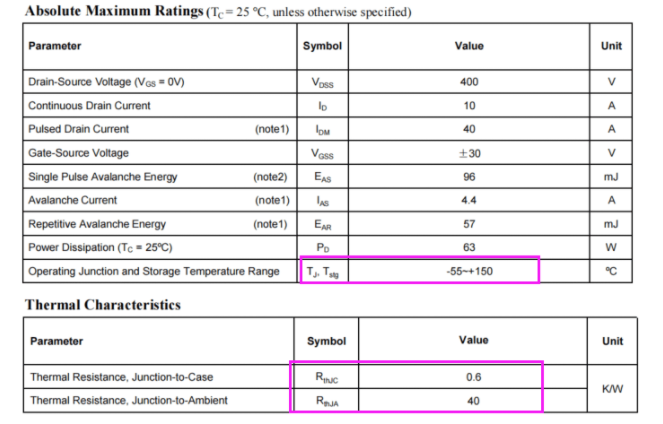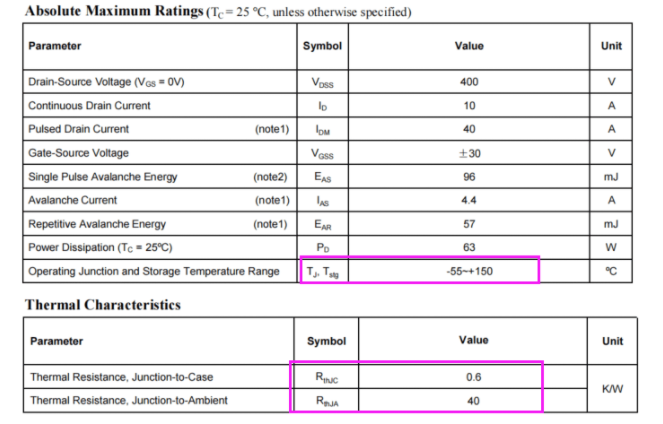

In this article, we will share the calculation methods for several key temperature parameters in MOSFETs: TJ (junction temperature), TA (ambient temperature), and TC (shell temperature).
1.The Importance of MOSFET Temperature Parameters
In power electronics applications, temperature is a key factor affecting the performance and lifespan of MOSFETs. Excessive temperature can lead to a decrease in device performance and even damage. Therefore, understanding and calculating these temperature parameters is crucial for ensuring the stable operation of MOSFET devices.
2. Definition of temperature parameters TJ TA、TC
a. TJ (Junction Temperature): refers to the temperature of the PN junction inside the MOSFET chip. It is the maximum temperature limit that MOSFETs can withstand during operation, and exceeding this temperature may result in device performance degradation, damage, or even failure.
b. TA (Environmental Temperature) "refers to the temperature of the surrounding environment where the MOSFET is located.
c. TC (Case Temperature): The temperature of the surface of the MOSFET casing. The calculation of junction temperature requires the use of thermal resistance parameters, which are introduced below.
3. Definition and Calculation of Thermal Resistance

Thermal resistance (R θ) is a parameter that measures the ease of heat transfer.
a. Thermal resistance from junction to case (R θ JC): represents the thermal resistance from the junction of MOSFET to the case.
b. Thermal resistance from shell to environment (R θ CA): represents the thermal resistance from the MOSFET shell to the surrounding environment.
c. Thermal resistance to the environment (R θ JA): R θ JA=R θ JC+R θ CA.
MOSFETs typically provide thermal resistance parameters such as junction to shell (R θ JC) and junction to environment (R θ JA). The thermal resistance can be obtained through the data manual.
4. Relationship between TJ, TA, and TC temperature parameters
TJ (junction temperature)=TC (shell temperature)+power loss x (thermal resistance R θ JC from junction to shell); Formula 1
TC (shell temperature)=TA (ambient temperature)+power loss x (thermal resistance R θ CA from shell to environment); Formula 2
Substituting Formula 2 into Formula 1 yields:
TJ (junction temperature)=TA (ambient temperature)+power loss x (thermal resistance from junction to shell R θ JC+thermal resistance from shell to environment R θ CA)
The power loss (Pd) is mainly composed of conduction loss and switching loss.
Conduction loss=I 2 × Rds (on) (where I is the conduction current and Rds (on) is the conduction resistance)
The calculation of switch losses is relatively complex, usually requiring consideration of factors such as switch frequency and driving voltage, and may require reference to formulas or curves provided in MOSFET data manuals.
5. Example of Temperature Calculation
Here are several practical cases for calculating MOSFET temperature parameters:
Example 1:
The on resistance RDS (on) of a MOSFET is 0.1 Ω, the on current Id is 10A, the thermal resistance R θ JA to the environment is 50 ° C/W, and the ambient temperature TA is 25 ° C. Firstly, calculate the power loss: P=Id 2 × RDS (on)=10 2 × 0.1=10W. Then calculate the junction temperature: TJ=TA+P × R θ JA=25+10 × 50=525 ° C
Example 2:
The on resistance RDS (on) of another MOSFET is 0.05 Ω, the on current Id is 5A, the thermal resistance R θ JC from the junction to the shell is 2 ° C/W, the thermal resistance R θ CA from the shell to the environment is 30 ° C/W, and the ambient temperature TA is 20 ° C. First, calculate the conduction loss: P=Id 2 × RDS (on)=5 2 × 0.05=1.25W. As the thermal resistance is in series, the total thermal resistance R θ JA=R θ JC+R θ CA=2+30=32 ° C/W, and the junction temperature TJ=TA+P × R θ JA=20+1.25 × 32=60 ° C
Example 3:
In high-frequency switching applications, a certain MOSFET has a switching loss of 5W, a conduction loss of 3W, a thermal resistance R θ JA to the environment of 60 ° C/W, and an ambient temperature TA of 30 ° C. Total power loss P=5+3=8W, junction temperature TJ=TA+P × R θ JA=30+8 × 60=510 ° C
6. Conclusion
Through the above calculations, we can see that the junction temperature of MOSFET may reach a very high level. Generally speaking, the maximum junction temperature that MOSFETs can withstand is limited. In design and use, it is necessary to ensure that the junction temperature does not exceed this limit value. Therefore, it is crucial to design a suitable heat dissipation scheme and monitor the temperature. As engineers at Shanghai Leimao Electronics, we are committed to providing high-performance MOSFET devices and providing customers with accurate parameter calculation guidance to ensure long-term stable operation of the devices.
Please note that the calculations in this article are only examples and should be calculated based on specific device parameters and operating conditions in practical applications. The device data manual and technical support provided by Jinan Lujing Semiconductor will help you calculate and evaluate temperature parameters more accurately.




